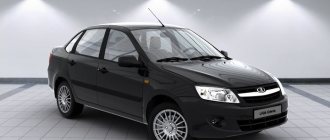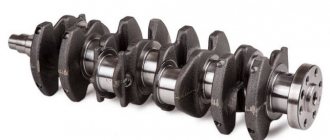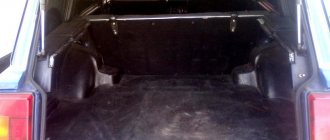Nowadays, few people are interested in such a characteristic of a car as its weight, and if they are interested, then in the last place. It is much more important for the average person to know his appetite, speed, cost and other indicators. Although, by and large, the weight of the car actually affects all its other indicators.
For example, the heavier the car, the more powerful the engine must be installed in it so that it can reach the required speed and accelerate to 100 km in a matter of seconds. The same can be said about fuel consumption - the heavier the vehicle, the more gasoline or diesel fuel it will need to move.
A car's directional stability and handling are also directly related to its weight. The peak of popularity of large, heavy cars abroad occurred in the 50-60s of the last century. Then the auto industry produced truly gigantic cars. For example, the Cadillac Eldorado modification 8.2 weighed almost 3 tons. Agree that for such a weight, an appropriate makeweight is needed.
But as time passed, it became clear that in order to further develop and improve the most important characteristics of the car, it was necessary to resort to reducing its overall weight.
And if we compare the middle of the last century and today, cars have lost half, or even more, of their own weight. Plastic, carbon fiber reinforced plastic, light metals - all these innovations have made it possible to make the weight of a passenger car significantly lower.
Of course, for lovers of everything big and heavy, cars are produced that look like steamships that drink buckets of gasoline, but this is rather an exception to the rule.
How much does a gas 53 engine weigh?
Device type - gasoline engine equipped with V8. Volume - 4.25 l. The maximum shaft rotation torque is 295 N/m. Weight - 262 kg.
Interesting materials:
How to open a coconut? How to open the console in Isaac Repentance? How to open masks on Instagram? How to open MP3 file in FL Studio? How to open new styles in MK 11? How to open the Steam overlay in Terraria? How to open Control Panel using hotkeys? How to open the bookmarks bar in Opera? How to open the mods folder in Sims 4? How to open beer with beer?
Car weights, table
We present to your attention a table that shows the weight of the car by brand.
| Brand | Model | Curb vehicle weight (kg) |
| Oka | 1111 | 635 |
| 1113 | 645 | |
| VAZ | 2101 | 955 |
| 2102 | 1010 | |
| 2103 | 965 | |
| 2104, 2110 | 1020 | |
| 2105 | 1060 | |
| 2106 | 1045 | |
| 2107 | 1049 | |
| 2108 | 945 | |
| 2109 | 915 | |
| 2111 | 1055 | |
| 2112 | 1040 | |
| 2113 | 975 | |
| 2114 | 985 | |
| 2115 | 1000 | |
| 2116 | 1276 | |
| 2117, 18, 19,20 | 1080 | |
| Niva | 2121 | 1150 |
| Gazelle | 3302 | 1850 |
| 33023 | 2050 | |
| 33027, 330202 | 2100 | |
| 330273 | 2300 | |
| 2705 | 2000 | |
| 2057 | 2220 | |
| 330232 | 2170 | |
| Sable | 2752 | 1880 |
| 2217, 22171 | 2130 | |
| Chevrolet | Cruz | 1285-1315 |
| Niva | 1410 | |
| GAZ (Volga) | 24, 2401 | 1420 |
| 2402, 2403,2404 | 1550 | |
| 2407 | 1560 | |
| GAZ (truck) | 53 | 3250 |
| 66 | 3440 | |
| 69 (8 seats) | 1525 | |
| 69A (5 seats) | 1535 | |
| ZIL | 130 | 4300 |
| 131 | 6790 | |
| 157KD | 5050 | |
| 433360 | 4475 | |
| 431410 | 4175 | |
| 431510 | 4550 | |
| MAZ | 5551 | 7470 |
| 53366 | 8200 | |
| Ural | 375 | 7700-8000 |
| 377 | 6830-7275 | |
| 4320 | 9750 | |
| 5557 | 9980 | |
| Muscovite | 412 | 1045 |
| 2140 | 1080 | |
| 2141 | 1055 | |
| 2335, 407, 408 | 990 | |
| UAZ | 3962, 452 (loaf) | 1825 |
| 469 | 1650 | |
| Patriot | 2070 | |
| Hunter | 1815 | |
| Nissan | x trail (x-trail) | 1410-1690 |
| Qashqai | 1297-1568 | |
| Juke | 1162 | |
| Ford | Focus | 965-1007 |
| Focus 2 | 1345 | |
| Focus 3 | 1461-1484 | |
| Kuga | 1608-1655 | |
| Escort | 890-965 | |
| Renault | Logan | 957-1165 |
| Duster | 1340-1450 | |
| Sandero | 941 | |
| Opel | Mocha | 1329-1484 |
| Astra | 950-1105 | |
| Mazda | 3 | 1245-1306 |
| cx-5 | 2035 | |
| 6 | 1245-1565 | |
| Volkswagen | Tuareg | 2165-2577 |
| Polo | 1173 | |
| Passat | 1260-1747 | |
| Toyota | Camry | 1312-1610 |
| Corolla | 1215-1435 | |
| Celica | 1000-1468 | |
| Land Cruiser | 1896-2715 | |
| Skoda | Octavia | 1210-1430 |
| Fabia | 1015-1220 | |
| Yeti | 1505-1520 | |
| Kia | Sportage | 1418-1670 |
| Ceed | 1163-1385 | |
| Picanto | 829-984 |
Thus, it turns out that if we take, so to speak, “in general for the hospital,” then the average weight of a passenger car is approximately 1 to 1.5 tons. » alt=»»>
The heaviest SUVs
Here are the SUVs that weigh the most
SUVs have never been famous for their amazing aerodynamics, power, dynamics, handling, etc. But times are changing. Many crossovers and SUVs these days can easily rival modern passenger cars. But there is one parameter that is very difficult for SUVs to overcome. It's about weight. Unfortunately, even the most expensive and stunning SUVs weigh significantly more than cars. The reason, of course, is their size, which becomes larger and larger over time. We have selected for you the heaviest modern crossovers and SUVs. To make it more interesting for you, we will start from smallest to largest.
16) Volvo XC90 T8 AWD (2,343 kg)
We'll start with the new generation Volvo XC90, which has grown significantly in size compared to its predecessor. For example, the almost 5-meter XC90 weighs 2.3 tons. So, despite modern technology and an aerodynamic body, don’t expect the new crossover to consume fuel like a moped. But nevertheless, we are talking about a hybrid version, which weighs a lot due to the battery and electric motor. So you can really save fuel. Unfortunately, this model is not available for purchase on the Russian car market.
15) Porsche Cayenne S E-Hybrid (2,350 kg)
Another heavy crossover also owes its weight to a hybrid powertrain. But thanks to the hybrid engine, the powerful Porsche Cayenne consumes, as the manufacturer claims, only 3.4 liters per 100 km. Agree that in this case the weight of the car is not important.
14) BMW X5 M (2,350 kg)
The powerful BMW X5 M, which is equipped with a large V8 engine, weighs exactly the same as the hybrid Porsche Cayenne. This crossover not only weighs a lot, but is also ready to surprise with its cost.
13) Mitsubishi Pajero 5-door (2,385 kg)
The five-door Pajero is a large SUV that has been produced by Mitsubishi for many years. This is the heaviest SUV among all models produced by the Japanese brand. Thus, the weight of the 3.2 liter model is more than 2.3 tons.
12) Tesla Model X (2,389 kg)
Batteries for any car are always a heavy burden and naturally an additional burden. But not for Tesla cars, which surprise from the very beginning with their acceleration dynamics, which only expensive supercars can match.
Nevertheless, our current rating, dedicated to the heaviest SUVs and crossovers, must include the new Tesla Model X 90D crossover; the model weighs 2.4 tons mainly due to its large battery.
Most likely the 100D model will weigh even more. Unfortunately, we don't have specifications for this version of the Tesla crossover yet.
11) Jeep Grand Cherokee 6.4 V8 SRT (2,418 kg)
The Jeep Grand Cherokee 6.4 V8 SRT is not only the brand's most powerful SUV, but it is also its heaviest. Thus, the 468-horsepower Grand Cherokee 6.4 V8 SRT weighs 2.4 tons, which allowed it to take 11th place in our rating.
10) Bentley Bentayga (2422 kg)
The Bentley Bentayga SUV, which is 5.14 m long, is equipped with a gigantic six-liter V12 engine. Many probably expected to see this model at the top of the ratings, since one might think that with such a large engine, a car must weigh a lot anyway. Yes, the Bentley Bentayga SUV naturally made it onto our list, but as you can see, it’s not the top TOP.
The fact is that this model is based on the same platform as the new generation Audi Q7 (MLB Evo architecture). The new platform allowed engineers to achieve significant weight savings in the Q7. It is logical that the Bentley Bentayga also has a similar weight, which is 2.4 tons.
9) Range Rover Sport 4.4 SDV8 (2,434 kg)
The Range Rover Sport is 30 centimeters shorter than the Bentley Bentayga and significantly weaker. The British SUV is equipped with a 4.4 liter 339-horsepower V8 engine. But what's most surprising is that the Range Rover Sport even weighs a little more than the super-expensive Bentley Bentayga.
 Mercedes GLE 500 x 4Matic (2,465 kg)
Mercedes GLE 500 x 4Matic (2,465 kg)
The successor to the ML-class is also present in our rating of heavy SUVs. The heaviest version of the Mercedes GLE is the hybrid modification. As we have already said, the culprit is the battery that powers the electric motor. Moreover, even when using lithium cells instead of lead, manufacturers still cannot reduce the weight of the batteries. As a result, as a rule, all hybrid vehicles weigh significantly more than their traditional counterparts.
We buy tires and wheels - another use of curb weight
How much horsepower does a KamAZ 5320 have? How much does a KamAZ weigh?
cost and modifications When buying new wheels for a car, there is a high risk of getting problems if the weight of the car does not correspond to the performance characteristics of the wheels. Otherwise, any, even minor, bump will have an adverse effect on their metal: alloy wheels will crack, steel wheels will bend.
It is also very important to take into account the weight of the car when choosing tires, since if you do not take into account the load index of the rubber, there is a high probability of unpleasant consequences. The most common problems that can be caused by a car’s weight not matching the tire load index include the following:
The most common problems that can be caused by a car’s weight not matching the tire load index include the following:
- The tread wears off fairly quickly.
- Destruction of the rubber cord, swelling/blowing of irregularities on the working or side surface of a part of the tire.
- Uneven wear of the rubber layer due to too high pressure.
- Lack of correct vehicle control, as tires change trajectory.
- Poor rolling, increased fuel consumption due to rolling resistance.
- Poor effect on braking distance.
- Inability to inflate wheels as required by the manufacturer's recommendations.
- Reduced safety of car operation for a number of reasons.
These are the consequences that can arise when purchasing wheels or tires when the curb weight of the car is not taken into account. This proves that this indicator is important for the operation of the vehicle.
In order to choose the optimal size of tires or wheels, you need to write down the curb weight of the car and divide this value by four, since all manufacturers of these products indicate the maximum weight in kilograms per tire.
All technical characteristics of a car are important during its operation, so the documents issued upon purchase should not be thrown away. They will not be needed until the warranty expires.
If for any reason you don't know the curb weight of your vehicle, you should know where you can quickly find it. To do this, you must always have at hand (for example, in the bookmarks of your Internet browser on your mobile phone) a website describing the technical characteristics of almost all vehicles. This information can be very useful, since such a catalog contains all the data on the total and curb weight of the vehicle. Accordingly, you have the opportunity, if necessary, to obtain reliable information about what parts to buy.
The car along with a full trunk and the maximum number of passengers (provided for by the design).
In other words, this is the maximum permissible weight of the car. By subtracting the curb weight from the total, you can get the carrying capacity of your vehicle.
Wikimedia Foundation. 2010.
See what “Gross vehicle weight” is in other dictionaries:
In the automotive industry and everything connected with this area, two basic concepts are used: curb weight of the car and gross weight of the car. These two characteristics are those that are necessarily discussed during theoretical classes held at a driving school. However, many, even very experienced, drivers do not know or have simply forgotten what lies behind this terminology.
Electric vehicles are different
Yes, electric trains are noticeably heavier than conventional cars. And if an EV model is created on the basis of a car with an internal combustion engine, then traditional layout restrictions also mean a compromise in weight distribution, because it is not so easy to find the optimal place for the traction battery.
Another thing is electric cars created from scratch, where the placement of the battery, electric motors and power electrics is already laid out at the design stage. Here, although the mass will be large, it will immediately be distributed successfully; fortunately, in the case of an EV, the layout possibilities are much wider. Spread the radiator all over the floor? No problem! Place the motors exactly on the axles? Please! As a result, the notorious 50:50 or the maximum lowered center of mass is quite easily achievable.
Cars for analysis in the Automotive Business ad database
Question of distribution
Let's get back to handling. It is influenced not only by the mass itself, but also by its distribution, in particular, the location of the center of mass, because the higher this point, the greater the roll, the worse the stability in corners, the greater the risk of capsizing under the influence of other negative factors. The location of the center of mass also affects weight distribution, which affects the nature of handling and steering (it can be neutral, excessive or insufficient).
Here are some examples. In sports cars, even basic fuel consumption affects the change in handling characteristics, so the shape and placement of the tank play a significant role. In conventional technology this is not so important, but installing additional equipment can lead to a shift in the center of mass.
For example, in hybrids the traction battery is usually placed above the rear axle, which entails a movement of the center of mass. But the manufacturer takes this into account and somehow compensates for the negative consequences, for example, by reconfiguring the chassis.
But switching to gas means the appearance of a heavy cylinder, which is usually placed either above the rear axle in the trunk, or in the rear overhang in the spare tire niche. There is also a shift in the center of mass here, but if this is not a factory version, then changes in the design of the car are not adjusted in any way. As a result, on slippery surfaces such a car will likely exhibit more oversteer than it initially did.
Or here’s another example - a large roof rack that can accommodate 50 kg of cargo. In this case, the center of mass will also shift upward, which will negatively affect the stability of the car. Its cornering behavior will really change. However, when creating the model, the manufacturer took this course of events into account and made allowances for the heavy load on the roof. So, if you do not exceed the permissible load, there will be no consequences. But the overload is already on the conscience of the driver.
And let’s separately touch on the distribution of mass along the axes. Surely everyone has heard about the optimal ratio of 50:50, which they strive for in terms of car handling. For this, they are ready to move the power unit closer to the base, send a gearbox to the rear axle (remember the transaxle scheme), move a heavy battery into the trunk...
The easiest way to achieve equal distribution is with the classic layout (engine at the front, drive on the rear axle), as well as with a central engine layout. Front-wheel drive cars, especially hatchbacks, typically have too much weight on the front axle and not enough on the rear. And in rear-engine supercars, the engine, hung behind the rear axle, actually acts as a pendulum, making the car too demanding of the driver’s actions when cornering. Of course, the ride character is adjusted by chassis parameters and suspension settings, but weight distribution still plays an important role in this matter.
Average car weight depending on type
There are many types of cars, which are classified according to a number of parameters. One of the main ones is weight. This approach is easily explained by the influence of this parameter on all other characteristics.
To better understand how cars are classified by weight, let's consider the most popular types, which include:
- Minicars. The engine of such cars rarely exceeds one liter. The minimum value is 0.4 l. Power of 15-40 horsepower is quite normal. Weight ranges from 0.5 to 0.8 tons. Such vehicles consume from 5 to 7 liters of gasoline per 100 kilometers. Maximum speed 100 km/h.
- Small cars. The engine capacity of such vehicles can reach two liters, but usually it ranges from 1 to 1.5 liters. Power is about 60-70 hp. The body can have either four or five seats. The weight of the car is from 0.8 to 1 ton. At the same time, the fuel consumption is 6-8 liters, and the speed is 110-120 km/h.
- Cars with medium displacement. The engine capacity in such cars is from two to three liters. Power is about 80-130 horsepower. Weight 1.2-1.6 tons. Fuel consumption is 12-14 liters. The maximum speed is 120-145 km/h.
- Cars with large displacement. The weight of such vehicles reaches 2.5-3 tons. They consume a lot of fuel. On average 18-20 liters per 100 km. Speed from 150 to 240 kilometers. The cabin can easily accommodate six or even eight people. The power of such machines can reach 300 hp.
Judging by the latest sales in Europe, every year the first two types of cars occupy an increasingly larger sales sector. This trend is easily explained by the desire of modern people to save money and not pollute the environment.
One model - different parameters
The vehicle's carrying capacity (payload) is determined by the simplest formula: gross weight minus curb weight. So you can easily calculate how much you can take on board your car. The main thing is to use data that relates specifically to your modification.
The fact is that the same model, depending on the version, may have different characteristics. Let's take, for example, the second generation Peugeot 308, which is so popular among us now. For version 1.6 HDI (120 hp) with manual transmission, the curb weight is 1185 kg, the total weight is 1780 kg. This is if we are talking about a hatchback, but for a station wagon you need to add another 15 kg. In any case, in addition to the driver, you can transport 595 kg, be it passengers or cargo. But if we take version 2.0 HDI (150 hp), then this is 1290 and 1870 kg, respectively, and the payload will be only 580 kg.
And this will be the case for all manufacturers. Modifications of the same model will differ in curb and gross weight, because they have different engines, transmissions, brakes, steering - and all this has an effect. Moreover, the data is often indicated in the range of 50-100 kg, taking into account the equipment, because the same air conditioning or electric sunroof adds extra pounds.
In Belarus, transport tax rates are tied to the gross vehicle weight, so this parameter can be of fundamental importance. We wrote on this topic not long ago, so we won’t repeat ourselves. Here we just note that when choosing a car, it is worth remembering that different modifications may have different total weight, and with “borderline” characteristics (say, the “fork” is in the range of 1480-1560 kg) there is a risk that you may “ get" to a higher tax rate.
Results
From all of the above, we can conclude that the weight of a modern passenger car is about 1.5 tons. Moreover, every year, thanks to modern materials, this figure is becoming smaller.
A car's directional stability and handling are also directly related to its weight. The peak of popularity of large, heavy cars abroad occurred in the 50-60s of the last century. Then the auto industry produced truly gigantic cars. For example, the Cadillac Eldorado modification 8.2 weighed almost 3 tons. Agree that for such a weight, an appropriate makeweight is needed.
But as time passed, it became clear that in order to further develop and improve the most important characteristics of the car, it was necessary to resort to reducing its overall weight. And if we compare the middle of the last century and today, cars have lost half, or even more, of their own weight. Plastic, carbon fiber reinforced plastic, light metals - all these innovations have made it possible to make the weight of a passenger car significantly lower.
Of course, for lovers of everything big and heavy, cars are produced that look like steamships that drink buckets of gasoline, but this is rather an exception to the rule.
How did the weight of cars affect the engineering industry?
Car manufacturers have long realized how important low weight is for dynamic performance. As a result, they tried their best to reduce the size of the main components. As evidence, we can recall the invention of the V-twin engine. It allowed us to halve the space under the hood of the car.
As an example, we can recall the Lykan Hypersport. Its body is made of carbon fiber. Due to this, the weight of the car is 1380 kilograms. At the same time, the car accelerates to hundreds in 2.8 seconds.
Average weight table of popular cars
To understand that modern automobile manufacturers are striving to reduce the weight of their creations, just look at the table below.
Curb vehicle weight (kg)
3962, 452 (loaf)
Focus 2
Focus 3
Land Cruiser
Modern passenger cars rarely cross the 1,500 kilogram limit. Of course, there are exceptions like the Ford Kuga, but they only further confirm the general rule, which states that the less a car weighs, the better for the consumer.
It's not just about better maneuverability and greater speed. A car with low weight requires significantly less energy to move. As a result, much less fuel is wasted. An important confirmation of this thesis is the ever-growing popularity of parquet SUVs, which hang relatively little and are a fairly economical mode of transport.
If we talk about general indicators, they range from one ton to 1.5. An interesting trend is the growth of the minicar segment. The weight of such machines can be less than a thousand kilograms. Leading experts associate all this with the same desire of people to save. In addition, small cars are much easier to park in the city. Especially when there is a shortage of free parking.
A short excursion into history
The best way to see how the weight of cars changed is in dynamics. Let's take cars from the 50s of the last century. They were real monsters. As an example that well illustrates the general trend, we can recall the Cadillac Eldorado 8.2. Its mass was three tons, and this was far from the limit in those days.
But with the onset of the oil crisis, automakers had to look for other ways to reach the hearts of consumers. The weight reduction has helped to significantly reduce fuel consumption. In addition, this had a positive effect on handling.
Features of car recycling
Before you scrap your car, you should familiarize yourself with the principles of this procedure.
The average weight of a vehicle is 1000 kg. If the entire car can be recycled, the collection point will deduct 30% for clogging. The latter includes all non-metallic elements, pollution, etc. Let's consider how much a car for scrap metal weighs using the example of a VAZ 2105. The weight of the latter is 955 kg. Thus, taking away the blockage, we get about 660 kg. You should also take into account the price of scrap, which differs depending on the city. As a rule, in megacities, the number of rubles received for a car will significantly exceed the amount earned in a similar organization in a small locality.
Before calculating the profit from a scrapped car, you need to take into account transportation costs. If the car is a pile of metal, you need to take care of a tow truck. If there are spinning wheels and functional steering, the car can be transported in tow. Then, this expense item will not be so significant. Therefore, in order to calculate how much a Zhiguli costs when scrapped, it is not enough to know how much a VAZ 2109 or 21099 weighs for scrap metal (915 kg). It is necessary to take into account the features of recycling and the requirements of collection points. It would be useful to know the average cost of scrap metal in the region. Additional awareness will allow you to avoid fraud on the part of unscrupulous receivers.
Despite the fact that disassembling a car is a labor-intensive procedure, many owners still decide to take this step. Thus, you can sort ferrous and non-ferrous metals and hand them over separately, removing the good parts. From an economic point of view, the procedure will be justified.
Let's consider how much a VAZ 2106 weighs for scrap metal based on individual significant structural elements:
It should be noted that dismantling machine parts requires a lot of time and certain skills. In the absence of the latter, it would be more rational to recycle it entirely.
Source of the article: https://lom.msk.ru/blog/skolko-vesit-avtomobil-vaz-sdannyj-na-metallolom/
The difference is hundreds of kilograms
To begin with, there are several different mass characteristics that differ significantly from each other.
The curb weight includes the weight of not only the vehicle itself, but also all filled technical fluids (oils, antifreeze, fuel), standard tools and a spare wheel. Moreover, this characteristic includes the driver's weight (75 kg). Only passengers and cargo are not taken into account, because with them there will be a total (maximum permissible) weight .
But there is also the so-called dry weight - without technical fluids, taking into account the driver’s weight, etc. The difference with the curb weight of even a passenger car can reach 150-200 kg, and in the case of commercial vehicles it can be more than half a ton.
What affects weight?
We have partially answered this question: even additional equipment and noise insulation have an effect, not to mention the “hardware” - transmission elements, power unit and body. Meanwhile, with each generation, the car, as a rule, becomes larger, the body increases both in size and strength, additional comfort and safety systems appear, and in recent years a course has been taken towards hybridization, and this also means additional weight. The “arms race” leads to increased performance, and accordingly the brakes become more powerful and the wheels have to be larger. Of course, all this entails an increase in mass.
Take, for example, the Opel Astra. In generation G, the curb weight (hatchback, 1.4, manual transmission) was 1060 kg, the total weight was 1605 kg. Astra H already weighed 1155 and 1705 kg, respectively. Astra J – 1300 and 1870 kg. But Astra K “went on a diet” - 1278 and 1820 kg. And this is also a trend: manufacturers are trying to reduce weight by using more modern technologies and lightweight materials.
It is rare that a modern car body can do without strong and ultra-strong alloys (they are used not only to increase rigidity, but also to reduce weight); on many models, external body elements are made of aluminum or plastic. However, many other parts, be they components of the body, engine or chassis, are also now made from lightweight materials, which in total saves tens of kilograms.
The suspension and brake parts are also lightened, but to a greater extent in order to reduce unsprung masses, since driving performance (handling, ride comfort) depends on this.
What does mass affect?
Of course, both the dynamics and fuel efficiency of the car depend on it. But not only. Weight also affects deceleration (a heavier car needs more powerful brakes), affects handling and stability (more on this below), and simply affects the service life of many components, from the engine, gearbox, transmission to suspension and steering parts.
It is no coincidence that depending on the installed engine, gearbox, and body type, springs, shock absorbers, stabilizers and brakes of different characteristics can be used. Accordingly, when purchasing spare parts, it is important to choose the parts that suit your particular vehicle modification.
Accordingly, when loading a car to its fullest, and even more so overloading a car beyond measure, one must understand that now its behavior on the road will change. The acceleration dynamics will become worse (which means that overtaking on the highway will be more difficult), the braking distance will increase, the car will become more inert in its reactions, and in turns it will roll more, and on a slippery surface it will be easier to provoke a drift or skid. Taking this into account, you should adjust your driving style and make a larger margin during potentially dangerous maneuvers.











